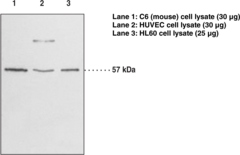| References |
| Synonyms |
- G Protein-Coupled Receptor 17
|
| Formulation |
peptide affinity-purified IgG in 500 µl TBS, pH 7.4, containing 50% glycerol, 5 mg/ml BSA, and 0.02% sodium azide |
| Stability |
1 year |
| Storage |
-20°C |
| Shipping |
Wet ice
in continental US; may vary elsewhere
|
| Specificity |
| Human GPR17 |
+ |
| Mouse GPR17 |
+ |
| Rat GPR17 |
+ |
|
Background Reading
Ciana, P., Fumagalli, M., Trincavelli, M.L., et al. The orphan receptor GPR17 identified as a new dual uracil nucleotides/cysteinyl-leukotrienes receptor. EMBO J 25 4615-4627 (2006).
| Size |
Global Purchasing |
| 500 µl |
|
Description
Antigen:
human GPR17 amino acids 351-367 (SFEGKTNESSLSAKSEL)
·
Host:
rabbit
·
Application(s):
ICC, FC, and WB
·
GPR17 is a G protein-coupled receptor that has been identified as a dualistic receptor recognizing signals from two unrelated chemical families: nucleotides and CysLTs.1 The deorphanization of GPR17 supports the suggested crosstalk between nucleotides and CysLTs during inflammation and injury. mRNA transcripts encoding this transmembrane receptor are most strongly expressed in the brain, kidney, and heart. Upon ischemic injury, GPR17 is upregulated in these tissues and its inhibition has been shown to decrease ischemic damage. This finding suggests GPR17 as a pharmacological target of ischemic injury.1 Cayman’s peptide affinity-purified polyclonal antibody recognizes the C-terminal region of human GPR17. This protein exists in two isoforms, differing by 28 amino acids at the receptor N-terminus. The longer form of the protein consists of 367 amino acids with a calculated molecular weight of 41kDa. The human and rat proteins share 89% amino acid identity.1 Post-translational modifications may explain the observed SDS-PAGE gel-migration to 57 kDa on immunoblot.
1
Ciana, P., Fumagalli, M., Trincavelli, M.L., et al. The orphan receptor GPR17 identified as a new dual uracil nucleotides/cysteinyl-leukotrienes receptor. EMBO J 25 4615-4627 (2006).
|






